Project Curator Emma Slocombe dedicated her decade at Knole helping to steer the Inspired by Knole project and leading curatorial research to inform the planning and implementation of re-presenting the conserved Knole showrooms and collections. Among her many achievements, she speaks about her personal highlights and most memorable challenges in what was then the longest conservation project within the National Trust.
Emma Slocombe on curatorial research and re-presenting Knole
Inspired by Knole, Project Curator 2007-2017
Interviewed by Veronica Walker-Smith in 2017
Curatorial research; Apollo publication on the Knole project
So, it would be true to say that with the Gatehouse Tower, we were really suffering from a lack of documentation, for instance, in relation to the historic showrooms at Knole, which had been opened for a very long time, that we almost have a surfeit of information that we can use. And also we have to think very carefully about how we target trips to the archives for example.
So, what don’t we know? What do we need to know? It’s actually the historical equivalent of breadcrumbs – to follow,, to take you to the piece of information that you are looking for. And one of the opportunities that came my way in 2016 was the opportunity to edit a Knole-specific edition of Apollo [international arts magazine]. National Trust Collections are published every year and they usually look at particularly ground-breaking and exciting research across the Trust.
And it was considered by David Adshead who was then Head Curator, that there was so much happening at Knole, so many conferences, so many exciting conversations with specialists in their field, that we would like to produce something specific for this house, to mark a moment in the project. And also because I knew that these new stories were coming forward, I didn’t want them to become then, footnotes in the story of the project, or a bigger publication that might come later. I wanted them to have their moment in the sun, because it’s exciting for us to discover these new stories.
So when I was looking at the make-up of the articles, the research that I thought would be useful to all of us at Knole, I was quite targeted in how I used that opportunity, to make sure that we got bits of research we really needed to help us on the project.
Re-presenting the showrooms; Wotton re-hang in the Ballroom
It was thrilling! There are always things that you worry about in re-presentation because you are working in 3-dimensional space with complex objects, and you’re thinking about different patinas on surfaces, different levels of finish, lighting and everything happens conceptually on paper. So it’s a combination of your conceptual framework you put around your work and then the reality of how that maps into the 3-dimensional space, and how it feels for visitors. And you actually don’t know until everything’s back in the room, that you’ve got the harmonies right.
A really good example is the re-hanging of the Wootton. So, moving the Wootton back from the Great Hall, back to its 1799 location in the Ballroom. The first satisfying thing that happened there was when we deconstructed that space, and it was empty, we found the 18th century pilaster which was put on that panelling to balance the 17th century pilaster so that when the painting was in there, the panelling around there was acting like a kind of extension of the frame. It gave it a kind of classical symmetry, and I’ve never even noticed this bit of painting until it was empty. And I was like, ‘Thank goodness!’ because I’d suspected I’d got the right wall, through of all the kind of documentary evidence and early photographs which recorded picture hangs elsewhere. So I kind of knew we were in the right place, but it kind of confirmed that it was the right space for it. And I was worried about how putting a picture that big in that space would look. And I worried about it right up until the moment it hung on the wall and I thought, ‘We made the right decision – it looks absolutely fantastic!’
Visitors' eye level engagement with great event at Dover
But also, you can actually see it. So, the picture lighting washes lighting down the front of that canvas, both atmospherically, but actually to enhance its visibility for our visitors. So, instead of going into that room and looking at that frame – which some people will still do, because it’s been conserved in the Conservation Studio here at Knole and it looks amazing – you are also at eye level with that wonderful processional route that the Duke of Dorset is taking to Dover Castle. So you can be an extension of that crowd in that painting, if you like. You can be part of the excitement that’s going on – the dogs, the boys, the fights, the drinking – you know, all of the things that surround a great 18th century event. I’m very pleased with that,
Challenge of lighting in an historic house
It’s been a long road with the lighting. And lighting in historic houses is problematic. It’s problematic because of all kinds of reasons: problematic because you’re trying to introduce wiring and the kind of background infrastructure into places where, unless they were really significantly re-wired in the 20th century, weren’t designed to take the lighting on the routes that you want. We certainly had to upgrade all the wiring in that side of the house. Getting the fittings right; choosing the right contractor. And understanding the aesthetic of light.
And that’s probably the most problematic of all, because if you’ve already got historic lighting in that space – as we have in the second part of the house – because we’ve got the picture lights from the early 20th century, actually choosing new fittings isn’t the issue. It’s actually getting the colour temperature right; or getting the right contemporary light sitting inside that doesn’t interfere too much with the historic lighting setting but actually works for a 21st century audience as well.
What I’m delighted about the re-fitting of the historic picture lights is that, depending on the size of the picture, have these little, tiny micro-spots inside the shell head itself. So you get one, two or three depending on the size of the painting. Our lighting designer, Sutton Vane & Associates, have put filters on them, to diffuse the light, so you get – not only do you get the colour temperature, so we’ve gone for something that feels as close to natural light as possible to work with a country house interior.
You get a much softer light than you would in a gallery where the lighting’s quite harsh, because you’re there for a different reason – engaging with the works of art in a different way.
Reynolds's self-portrait; chandeliers in Cartoon Gallery
The most exciting thing for me, aside from re-fitting the picture lights – and I will just say before moving on to the most exciting thing: I did cry when I saw the Reynolds Room, because I saw the portrait, the self-portrait of Reynolds in a way that I’ve never seen it before. And I stood in front of that picture and I thought, ‘ I’ve known this picture for 10 years and I’ve never really seen it.’ And it was very moving for me, because it was the culmination of so many years’ work.
But the most thrilling thing is the chandeliers – it’s got to be the chandeliers in the Cartoon Gallery! Where I’ve been waiting to re-instate chandeliers in that gallery for 10 years. And they’re in and I’m like, ‘whoo!’
Interviewer: As long as that?
Emma: As long as that. I can see them in all the historic photographs. And you can’t introduce an object out of context. You’ve got to have a project, and a plan, and understand that, you know, the presentation of the whole. But actually, it always felt to me that there was something lacking in that space and now it’s all the richer for those washes of light that come down from those chandeliers. And they weren’t electric originally. So the chandeliers were electrified along with the introduction of electricity elsewhere. But the chandeliers had been in that space a lot longer.

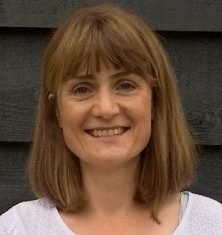
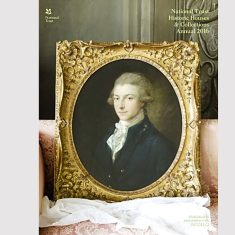
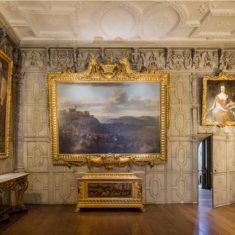
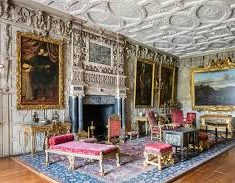
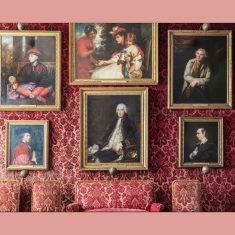
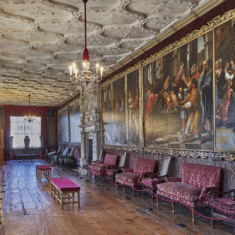





No Comments
Add a comment about this page